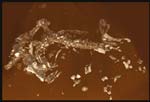Literature
Gaudin, T. J., and A. A. Biewener. 1992. The functional morphology of xenarthrous vertebrae in the armadillo Dasypus novemcinctus (Mammalia, Xenarthra). Journal of Morphology 214:63-81.
Hildebrand, M. 1985. Digging of quadrupeds, pp. 89-109. In M. Hildebrand, D. M. Bramble, K. F. Liem, and D. B. Wake (eds.), Functional Vertebrate Morphology. Belknap, Cambridge.
Hu, Y.-M., Wang, Y.-Q., Luo, Z.-X., and C.-K. Li. 1997. A new symmetrodont mammal from China and its implications for mammalian evolution. Nature 390:137-142.
Hu, Y., Wang, Y., Li, Ch., and Z.-X. Luo. 1998. Morphology of dentition and forelimb of Zhangheotherium. Vertebrata PalAsiatica 36:102–125.
Jenkins, F. A. Jr., and F. R. Parrington. 1976. Postcranial skeletons of Triassic mammals Eozostrodon, Megazostrodon and Erythrotherium. Philosophical Transactions of the Royal Society of London, B 273:387-&.
Ji, Q., Luo, Z.-X. and S.-A. Ji. 1999. A Chinese triconodont mammal and mosaic evolution of the mammalian skeleton. Nature 398:326-330.
Ji, Q., Luo, Z.-X., Yuan, C.-X., Wible, J. R., Zhang, J.-P., and J. A. Georgi. 2002. The earliest known eutherian mammal. Nature 416:816-822.
Kielan-Jaworowska, Z., and P. P. Gambaryan. 1994. Postcranial anatomy and habits of Asian multituberulcate mammals. Fossils Strata 36:1-92.
Kielan-Jaworowska, Z., Cifelli, R. L., and Z.-X. Luo. 2004. Mammals from the Age of Dinosaurs: Origins, Evolution and Structure. Columbia University Press, New York.
Kumar, S., and S. B. Hedges. 1998. A molecular timescale for vertebrate evolution. Nature 392:917-920.
Krause, D. W., and F. A. Jenkins. 1983. The postcranial skeleton of North American multituberculates. Bulletin of the Museum of Comparative Zoology 150:199-246.
Luo, Z.-X., Crompton, A. W., and A.-L. Sun. 2001. A new mammaliaform from the Early Jurassic and evolution of mammalian characteristics. Science 292:1535-1540.
Luo, Z.-X., Kielan-Jaworowska, Z., and R. L. Cifelli. 2002. In quest for a phylogeny of Mesozoic mammals. Acta Palaeontologica Polonica 47:1-78.
Luo, Z.-X., Ji, Q., Wible, J. R., and C.-X. Yuan. 2003. An Early Cretaceous tribosphenic mammal and metatherian evolution. Science 302:1934-1940.
Martin, T., and B. Krebs (Eds.). 2000. Guimarota: A Jurassic Ecosystem. Verlag Dr. Friedrich Pfeil, Munich.
McKenna, M. C., and S. K. Bell. 1997. Classification of Mammals above the Species Level. Columbia University Press, New York.
McLeod, N., and K. D. Rose. 1993. Inferring locomotor behavior in Paleogene mammals via eigenshape analysis. American Journal of Science 293:300-355.
Murphy, W. J. et al. 2001. Resolution of the early placental mammal radiation using bayesian phylogenetics. Science 294:2348-2351.
Novacek, M. J., Rougier, G. W., Wible, J. R., McKenna, M. C., Dashzeveg, D., and I. Horovitz. 1997. Epipubic bones in eutherian mammals from the Late Cretaceous of Mongolia. Nature 389:483-486.
Nowak, R. M., and J. L. Paradiso. 1983. Walker's Mammals of the World. Johns Hopkins University Press, Baltimore, 4th edition.
Prothero, D. R. 1981. New Jurassic mammals from Como Bluff, Wyoming, and the interrelationships of non-tribosphenic Theria. Bulletin of the American Museum of Natural History. 167:281-325.
Rose, K. D. 2000. Burrowing adaptations in vertebrates, pp. 220-226. In R. Singer (ed.), Encyclopedia of Paleontology, Volume 1. Fitzroy Dearborn, Chicago and London.
Rougier, G. W., Wible, J. R., and M. J. Novacek. 1998. Implications of Deltatheridium specimens for early marsupial history. Nature 396:459-463.
Rougier, G. W., Ji, Q., and M. Novacek. 2003. A new symmetrodont mammal with fur impressions from the Mesozoic of China. Acta Geologica Sinica 77:7–14.
Rowe, T. B. 1988. Definition, diagnosis, and origin of Mammalia. Journal of Vertebrate Paleontology 8:241-264.
Simpson, G. G. 1929. American Mesozoic Mammalia. Memoirs of the Peabody Museum of Natural History, Yale University 3:1-171.
Szalay, F. S. 1994. Evolutionary History of the Marsupials and an Analysis of Osteological Characters. Cambridge University Press, Cambridge.
Weil, A. 2002. Mammalian evolution: upwards and onwards. Nature 416:798-799.




 ,
, 





